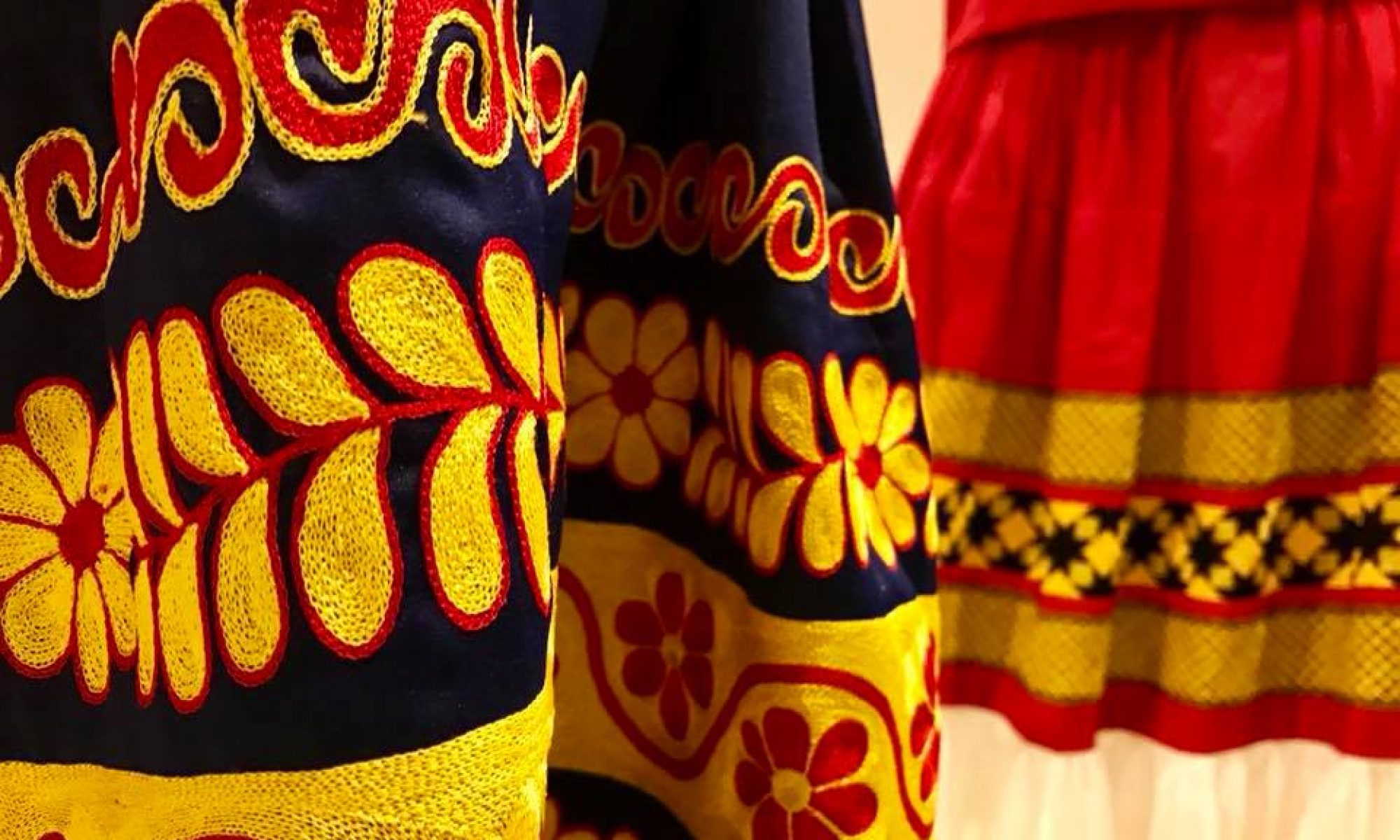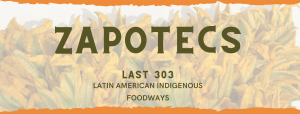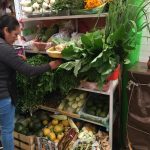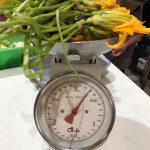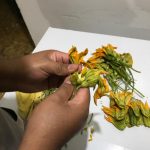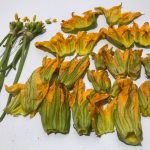Food waste

Source: Fix.com Blog
Drinking Tap Water – A reality for few

Figure 1. Can you guess what this is?

Figure 2. Can you guess what this is?
Do you know what these images are?
That was the question I asked my friends on Instagram. Most of my Mexican and Latino friends knew exactly what the images were, while my Canadian, American and European friends did not.
What about you? Do you know what these images are?
If you do, I will assume you grew up or have been in a place where drinking water directly from the tap is not safe. If you have no idea what they are, it is okay. I will try to explain. Both images show tools that people use daily to facilitate serving water from a carboy.
In how many countries is it not safe to drink water directly from the tap?
I love random facts, so here is one. According to the Centers for Disease Control and Prevention (CDC), in 187 countries, you cannot drink water directly from the tap. The Globehunters (2019) published the following infographics showing the places where, as a tourist, it is safe and unsafe to drink tap water.

As you can see in the infographics, the countries with drinkable water are mostly the ones cataloged as “Developed countries” or “High-income countries.”
While it can be annoying for tourists from developed countries to travel to destinations where they can no longer drink water directly from the tap, most of the world has to pay for every single cup of water they drink and not just for the holidays, but for their entire lives.
As a developing country citizen (Mexican) who lives in a so-called developed country (Canada), I found the tremendous differences in access to drinking water across countries fascinating and frustrating. In this article, I will use the example of water quality to discuss the Kuznets Curve.
Tap water and the Kuznets Curve
After a year of drinking tap water, paying for a water bottle made me think of the Environmental Kuznets Curve (EKC) that we explored in my Environmental Economics class at the University of British Columbia (ECON 371).
The EKC, broadly speaking, represents the hypothesized relationship between income per capita (how much money a person makes on average) and environmental degradation. As you can see in Figure 3, in the beginning, with low income per capita, environmental degradation increases until it reaches a maximum. Then it decreases as income per capita keeps increasing (Stern, 2004).
The EKC is named after Kuznets (1955), who hypothesized that income inequality is an inverted U-shaped function of income per capita (Stern, 2004).
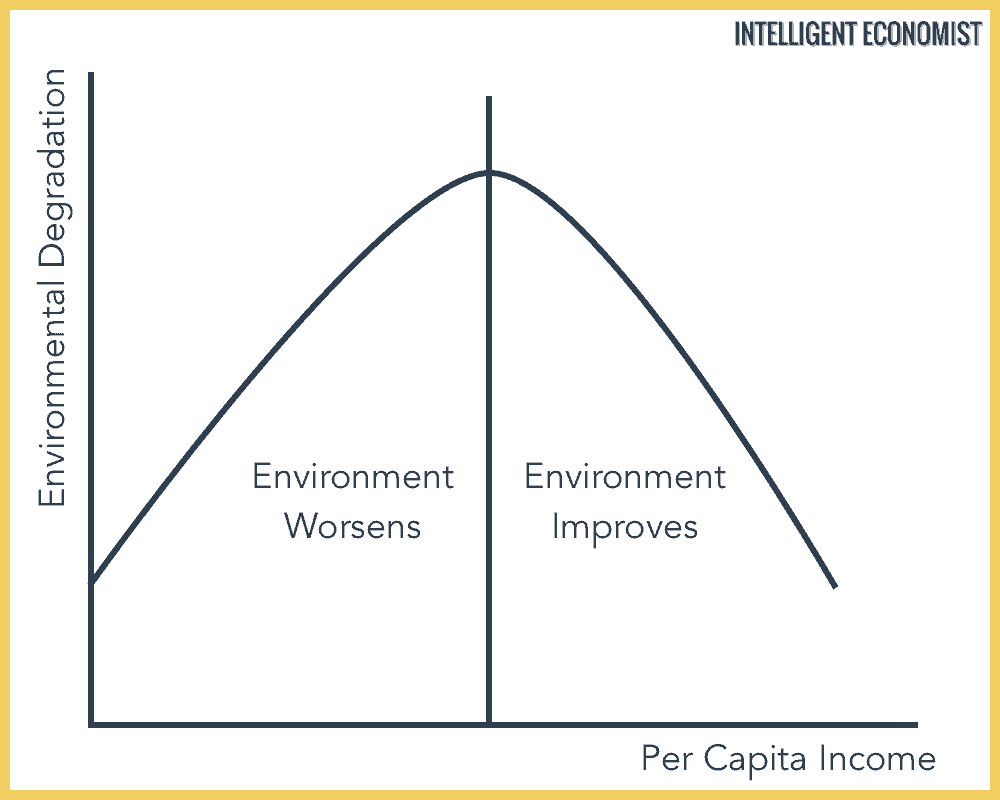
Figure 3. Environmental Kuznets Curve
If you do not like graphs because you think they oversimplify the complex world, I totally agree with you. However, remember that while all models fail to accurately represent the world, some models are useful.
The graph could be used to explain why in some countries you can drink tap water while in others you cannot. It would also explain the difference in water quality across different countries. If we are optimists, the Kuznets curve can even give us hope that as income per capita continues to increase beyond the turning point, we would not only afford to have more stuff, but the quality of the environment would improve as well. Best of both worlds, right?
At this point, the hypothesis seems too good to be true.
So I did some reading. I found that many researchers in different parts of the world have analyzed data to see if the hypothesis holds true for different environmental indicators. Soumyananda Dinda, in his paper “Environmental Kuznets Curve Hypothesis: A Survey” (2004), analyzes EKC papers that have used municipal solid waste, urban sanitation, access to safe drinking water, energy use and traffic volumes, etc. to test the hypothesis. He found that most of the indicators do not support the EKC. He also found that:
1.- Environmental problems that directly impact human health (such as urban sanitation and clean water) tend to improve steadily with economic growth.
2.- When environmental problems can be externalized (such as municipal solid waste), the curve does not fall at high-income levels.
His findings are consistent with what Field discusses in his book Environmental Economics (2017).

Figure 4. Environmental Indicators in Relation to Country Income Levels
Before I jump to my conclusions, I would like to add the two critical assumptions of the EKC. I hope the assumptions would make you think about why the EKC does not hold for certain indicators, and how we could use the information that the model provides.
Two critical assumptions about the EKC are: Environmental degradation has to be reversible, and as people become richer, they care more for the quality of the environment (Dinda, 2004).
Conclusions
Environmental quality varies greatly across the globe. An example is that some countries have drinking tap water while others do not. The Environmental Kuznets curve reflects the hypothesized u-shaped relationship between environmental degradation and income per capita. However, most empirical evidence does not support the EKC. Researchers have explored different reasons why the EKC does not hold. More research needs to be done to better understand and tackle environmental degradation and climate change.
References
Dinda, S. (2004). Environmental Kuznets curve hypothesis: a survey. Ecological economics, 49(4), 431-455.
Field, B. C., & Field, M. K. (2017). Environmental economics an introduction. The McGraw-Hill.
Stern, D. I. (2004). The rise and fall of the environmental Kuznets curve. World
development, 32(8), 1419-1439.
Images:
Figure 1. https://chrisalim.net/wp-content/uploads/2020/07/BOM-1306-04.jpg
Figure 3. Environmental Kuznets curve obtained from https://www.intelligenteconomist.com/kuznets-curve/
Figure 4. Environmental Indicators in Relation to Country Income Levels http://ndl.ethernet.edu.et/bitstream/123456789/43102/1/4.pdf (p.425)
Unrequested post
Note: this is not my Unit 6 post. This is just me finding a place to share what I read.
I read this in my econ class, and I got so frustrated. So, I decided to share it here, hoping that sharing it would help me deal with the emotions.
“The poorer countries of the world confront tragic choices. They cannot afford drinking water standards as high as those the industrial countries are accustomed to. They cannot afford to close their pristine areas to polluting industries that would introduce technical know-how and productive capital and that would earn urgently needed foreign exchange. They cannot afford to bar mining companies from their unexploited regions. Nor can they afford to impose antipollution requirements on these companies that are as strict and expensive as those in richer industrial countries. They should always realize that environmental protection measures are financed out of the stomachs of their own people; the multinationals cannot be made to pay for them.”
Robert Dorfman, “An Economist’s View of Natural Resources and Environmental Problems,” in Robert Repetto (ed.), The Global Possible, Yale University Press, New Haven, CT, 1985, 67–76.
Blog 8 – Self-centered: reflections from LAST 303 and the Waorani
“If you have come here to help me, you are wasting your time. But if you have come because your liberation is bound up with mine, then let us work together.”
I can’t believe this is the last blog I will be writing for this class.
This week I was assigned the Waorani. I really enjoyed it.
Big thanks to Alara Sever, Geneviève Lalonde, and Katerina Vyskotova, you did a great job!
While reflecting on this term, I noticed the strong sense of community in every one of the Indigenous groups we studied. For the Shipibo Konibo, the Garifuna, the Maya, the Quechua, the Zapotecs and the Waorani, the community and reciprocity were key.
Lately, I have been stressing and trying to unsuccessfully fight insomnia. I have been trying to balance academics and work while trying to comply with pandemic safety measures. I think it is quite easy to complain and be self-centred during these times. Realizing how self-centred I have been this term made me admire even more the sense of community of all the groups who have fought for centuries for their autonomy and the self-donation of many members for the well-being of their community. For example, how Nelida from “Hija de la laguna” decides to go live in an urban setting that she doesn’t enjoy, so she can protect community members from the injustices of mining companies and the government. Or Alicia Cawiya and Nemonte Nenquino, Waorani women, that dedicate their lives to fight for nature, which they feel is also part of their community.
Their example made me reflect on my own actions. I think it is necessary, and I should take action now despite the pandemic, despite being a student busy with school and work. Life won’t get any less busy afterwards. I should incorporate standing for others and fighting for what I care about today because no one knows anything about the future.
Anyways, another quote for the final season:
“It’s hard to find the rhythm when the rhythm keeps changing. Go easy on yourself.”
Unit 6: Zapotecs
1: General information
After watching the Chef’s Table episode on Enrique Olvera, it is likely that we are all familiar with the Mexican state of Oaxaca: one of the most ethnically and linguistically diverse regions of America. Located in southeastern Mexico along the Pacific Ocean coast, where the southern and eastern Sierra Madre intersect (Quinto-Cortés et al. 410), Oaxaca is often recognized by its beautiful coastal and highland valleys, rugged mountains and ethnic diversity (Joyce). While there are more than 60 Indigenous populations in Mexico, Oaxaca is home to the majority of them (Quinto-Cortés et al. 410). The Zapotecs are one of these various ethnolinguistic Indigenous groups in Oaxaca, and they are considered to be one of the most important cultures within Mesoamerican civilizations (Joyce). The Zapotecs live in four geographic regions of Oaxaca: the Central Valley, the Istmo, the Northern Sierra and the Southern Sierra (Luna-José 2). Together, the Zapotecs and the Mixtecs, another Indigenous group in Oaxaca, constitute just under 70 % of the Indigenous population in Mexico (Pavón 2), but the Zapotecs alone represent the third largest Indigenous group in Mexico (Luna-José 2). The present-day cultural diversity is rooted in the pre-Hispanic era, and despite the significant turmoil of the Spanish Conquest, pre-Hispanic traditions still greatly influence the lives and understandings of Indigenous communities (Joyce).

When roaming a market in Oaxaca, it is likely you will hear various native languages spoken, along with Spanish. It is no surprise that language, as a crucial feature of social cohesion, is an area of great diversity in Oaxaca, due to the fact that Oaxaca has a rich collection of different languages and dialects (Quinto-Cortés et al. 410). Around the time of the Spanish Conquest, there were probably over a million Mixtec, Chatino and Zapotec speakers (Quinto-
Cortés et al. 410). However, the uneven distribution of fertile lands divided by high mountains encouraged isolation, therefore influencing the emergence of linguistic and cultural diversity (Quinto-Cortés et al. 410). Today, at least 16 distinctive language groups are identified in Oaxaca, along with Spanish (Joyce); and in terms of language preservation, the Zapotecs have shown a great resistance to the loss of their native tongue (Saynes-Vásquez et al. 2).
2: Ecological knowledge and Classification Systems
Ecological Knowledge
Global changes that affect local communities have the potential to cause severe loss of ecological knowledge (Saynes-Vásquez et al. 2). Saynes-Vásquez et al. refer to this knowledge as “Traditional Ecological Knowledge” (TEK), which is the “knowledge, beliefs, and practices that have to do with the relationship that human societies have with their natural surroundings” (2). Their study analyzed cultural change among the Zapotec peoples, specifically those from the Isthmus of Tehuantepec. They found that cultural change experienced by these peoples, as a result of regional development processes, is related with the deterioration in TEK (Saynes-Vásquez et al. 9). They also claim there has been a significant decrease in local botanical knowledge as a result of the change in occupational activities, from primary activities to secondary economic activities and services, which has forced a large portion of the population to have less contact with the natural surroundings (Saynes-Vásquez et al. 9). Their data suggests that formal education programs disregard local knowledge and encourage a change in cultural attitudes that support a more urban lifestyle, while deflecting the attention away from nature and the local natural environment (Saynes-Vásquez et al. 9). In addition, schooling is also a contributing factor, as it encourages neglect of the native tongue which Saynes-Vásquez et al. describe as the “fundamental instrument of transmission of local knowledge” (9). Lastly, ethnobotanical knowledge itself is decreasing rapidly due increased deforestation (Saynes-Vásquez et al. 9).
Classification Systems
Traditional classification systems are examples of expressions in traditional knowledge, and, for the Zapotecs, knowledge that is produced through daily exchanges with plants and animals, as well as elements such as climate and soil, is organized and integrated in distinct ways (Luna-José 2). A study that aimed to both (1) describe traditional ecological knowledge through classification and (2) determine the role this knowledge plays in plant resource management and conservation, was conducted in the Zapotec municipality of San Agustín Loxicha, in the Sierra Sur of Oaxaca. The Zapotecs of this region heavily rely on agriculture and gathering of forest products to support themselves, and it is their connection with nature in daily life that has allowed for knowledge to be constructed about plant resources (Luna-José 2). This knowledge is reflected in traditional classification systems, particularly the plant classification system. Luna-José and Aguilar found that based on both ecological and morphological characteristics, the Zapotecs name and group plants in a hierarchic system; however, they not only recognize, name and classify plants that are useful to them for medicinal or nutritional purposes, but also plants that don’t offer an immediate use (Luna-José 10). Due to the different strategies Zapotecs have developed through generations, such as using plants for timber, food and medicine, and being in charge of their own productive systems (milpa, etc.), they have become experts in their field through experimentation and hold a high level of traditional ecological knowledge (Luna-José 11).
3: Foodways
As a reminder: foodways may be understood as the beliefs, behaviors, and practices surrounding the production, distribution, preparation, and consumption of food. Zapotec traditional agriculture systems used Milpa: squash, beans and maize, also known as the three sisters. Zapotec diets also included maguey, cacao, chilis, and a wide variety of wild plants. Spanish introduced new crops and domesticated animals to the Zapotec culture shortly after the conquest. Sugarcane, lettuce, onions, radishes, pomegranates, melons, and lemons are among the crops introduced by the Spaniards (Whitecotton 177). Today, Mexican cuisine is a fusion of native and new crops. In this section we will focus on two native crops: squashes and maguey.
Squashes
In Mexico, squashes, pumpkins and gourds (Cucurbita spp.) were domesticated around 10,000 years ago. The wild forms of Cucurbita do not have a pleasant taste (bitter) to humans. Although wild Cucurbita species declined, they thrived in domestication, and there are now hundreds of different varieties of Cucurbita grown worldwide (Kistler et al. 1). Cucurbita varieties differ in shape, size, and flavor and Zapotecs have been using them for millennia as part of their diets (Mulík and Ozuna 1). Zapotecs eat not only the fruit, as you have probably tried before, but they also eat the young stem, seeds, leaves and blossoms. In Oaxaca, squash blossoms, also known as “flor de calabaza” or “flor de pipiana” are very popular and are sold in markets either alone or with other edible parts of the plant. The flower is sold in bunches by local producers. Once the flower has been removed from the plant, it has a relatively short shelf life (2-3 days in the fridge). That helps to explain why most of the flor de calabaza eaten in Oaxaca comes from nearby locations. Cucurbita is used in numerous recipes and preparation varies among Zapotec groups and families. For squash blossoms alone, more than 40 recipes that use them as the main ingredient have been documented (Mulík and Ozuna 4). The two most common ways to eat them are in soups and as a filling in a great variety of Mexican dishes such as tamales or quesadillas. However, nowadays, they are used in Mexican haute cuisine in salads and desserts.
Figure 2. Flor de calabaza getting ready to be cooked.

Maguey
Maguey is generally grown in less fertile land, and it has a variety of uses. The use of maguey has changed with time. Before the arrival of the Spaniards, the stock of the maguey was roasted and eaten, a syrup was made from the plant, and the maguey’s fibres were used for clothing for the peasant class (Whitecotton 134). Pulque, an alcoholic beverage made from maguey was also consumed. The production origin of Mezcal, another alcoholic beverage obtained from maguey, is still very controversial. Some anthropologists affirm it was not produced in pre-Spanish times (Whitecotton 134), while others suggest that Mezcal was produced up to 25 centuries before the Spanish arrived (Goguitchaichvili et al. 1). Even if we are not sure about its exact origin, mezcal is a great example of Indigenous foodways beyond food consumption, as it is often used in healing. In contrast to Western thinking, in the Zapotec cosmovision, the world is not segmented into physiological, psychological, social and cosmic phenomena (López-Sanchez and Douglas 237). In Indigenous communities, foods such as eggs and mezcal are frequently used in healing by curanderos. The two main illnesses they are used for are tiricia (sadness of the soul) and mal de ojo (evil eye) (López-Sanchez and Douglas 239). The treatment consists of a limpia (a spiritual cleansing) where an egg is passed over the body and broken open in a glass of water for the diagnosis. It is then followed by brushing the body with mezcal, basil, rue, and copal incense (López-Sanchez & Douglas 239).
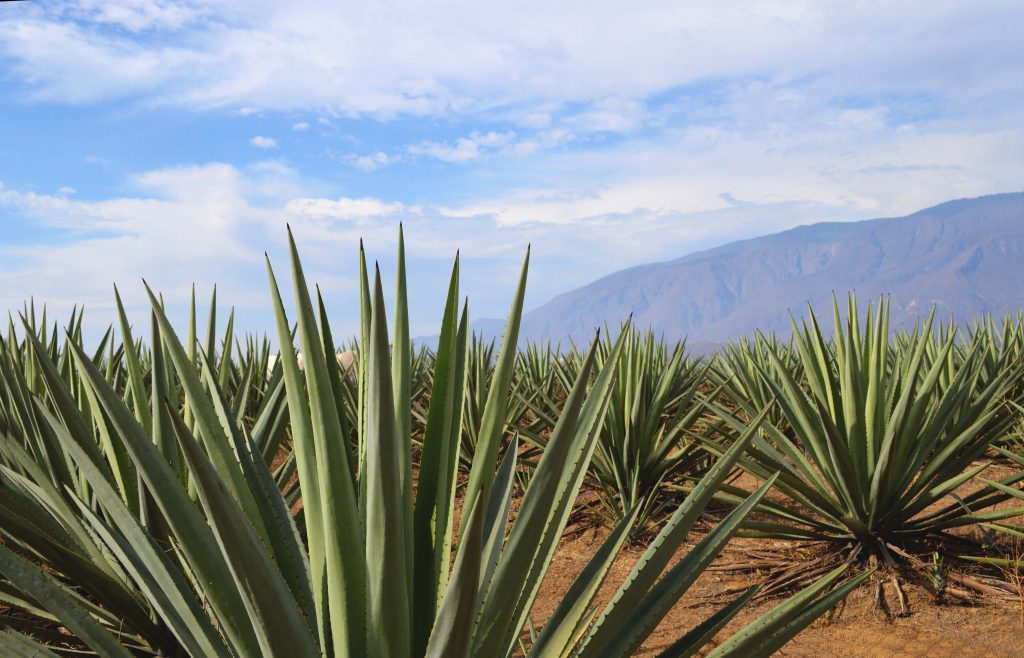
Mezcal also allows us to appreciate the role of globalization in Zapotec culture. Until a couple of years ago, Mezcal was not a word that foreigners would recognize while reading a drinks menu. However, in the last decade it has received a lot of media attention and exports have increased substantially (Bowen 128). Most of the exported Mezcal is produced by bigger distilleries that are able to profit from economies of scale and afford certification. Many of the small mezcal producers have been forced out of business (Bowen 130).
4: Agriculture
Agricultural Knowledge Systems
The Zapotec knowledge systems heavily stem from their knowledge of agricultural practices and their process of growing key crops. Referring back to the keywords, knowledge systems encompass practices, theories, instruments and people who together help acquire knowledge that contribute to the lifestyle of an Indigenous group. In context of the Zapotec, their large-scale success is heavily associated with the extensive and efficient development of agricultural technologies that allowed their community to grow squash, maize, and beans. Because the Zapotec were located in valleys and mountainous terrain, traditional farming methods as we know them would be difficult and inefficient. The Zapotec developed elevated agriculture technologies that would allow them to grow and sustain crops to feed their people. The Oaxaca valley allowed for an advantageous head start due to the large flat floor, high water table, low erosion rate and frost-free floodplain (Flannery et al. 446). As a result, the Zapotec also developed water features and land structures that facilitated the growth of squash and other key crops resulting in an abundance of nutrient filled food.
-
-
Barbecho rotation system
-
The Zapotec used the Barbecho rotation system that allowed land to be used and reused for agriculture purposes. As a refresher, Barbecho is when land is used for agriculture for 1- 2 years and then left to rest and re-fertilize for another 2-3 years. This agricultural technique allows land to re-establish nutrient-rich soil through a natural process, without causing long-term damage on the environment. This benefits both the Zapotec and the environment. Barbecho is reflective of the relationship the Zapotec have with nature. The Zapotec knew that if they were to obtain resources from the land, they must treat the land with care. This form of reciprocity shows how the Zapotec values are visible in many areas of their lifestyle, down to the cultivation of their food.
-
-
Canal Irrigation
-
Irrigation systems are one of the earliest forms of efficient pumping to date. These were multipurpose systems that facilitated water access used for the drainage of waste, farming and personal uses. Canal irrigation is a type of irrigation system that was used in Zapotec communities which was particularly important for agriculture. These water channels ran through the agricultural terrain and provided water from a water source (usually a dam) to farms located in different areas. The objective of this practice is to facilitate water access and to also reduce crop failure caused by erosion and degradation of water quality. By using water channels, it also created efficient use of water by minimizing conveyance losses from seepage or structural failure. As a result, canal irrigation became a key technology that contributed to the success rate of crop growth due to its multipurpose benefits in agriculture.
-
-
Terrace farming
-
As mentioned earlier, the Oaxacan valleys made it difficult to use the same farming methods as used on flat surfaces. The solution was to work with the land by implementing a technique that would support crop growth. As a result, Terrace farming became an innovation used by the Zapotec that contributed to successful food production. Terrace farming is a level farming technique that is distinguished for its step-like structure. It is useful in mountainous terrain, valleys or hills because it is the most efficient to sustain crops and prevent ecological damage. The small plateau of each level plays a number of significant roles to the sustainability of crops. Firstly, it prevents water from seeping down the hill, ensuring that crops receive sufficient water. This also prevents soil erosion from occurring, which is also a way to keep nutrients from draining down the land. Secondly, the level-like structure also acts as a form of stability on uneven ground: this prevents mudslides from occurring and ruining farmland and growing crops. Terrace farming was and continues to be a commonly used technique in many areas of the world. Due to its innovative structure, it provided the ability to farm on rugged land helping support and sustain civilizations.
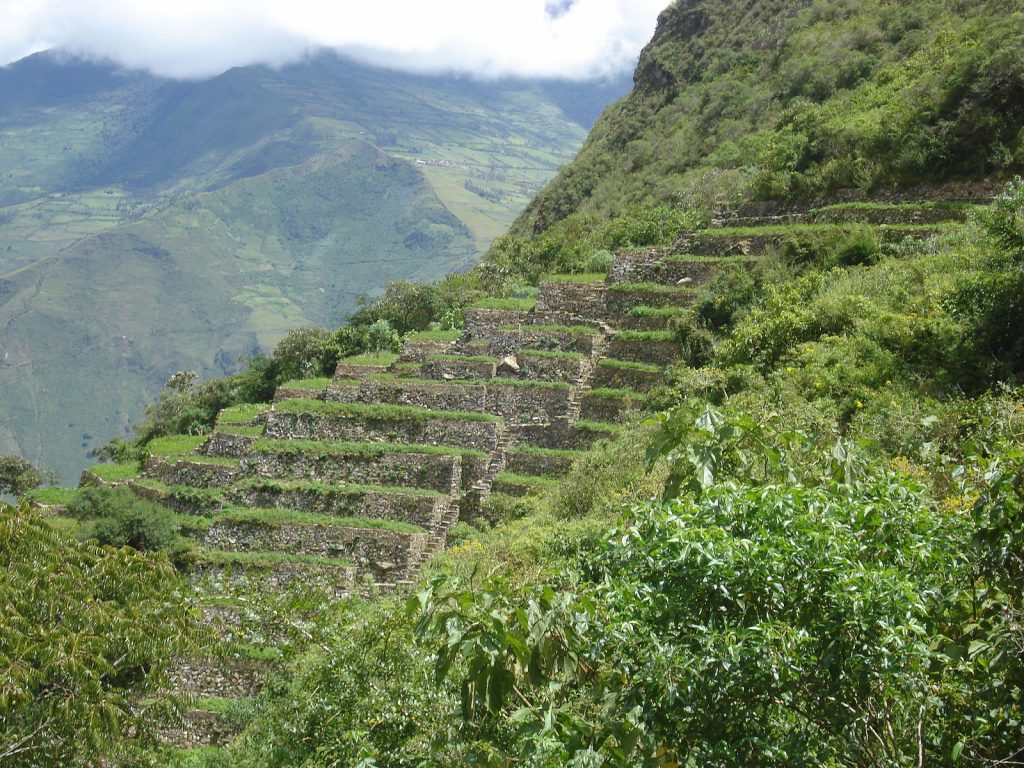
Agricultural changes
For more than 5000 years, the Zapotec have developed and evolved techniques for producing, processing, preserving and preparing squash and other crops… to the point that agricultural surpluses supported a series of civilizations, including that of the Olmec, Maya, Toltec, Aztec Zapotec and Mixtec (Gonzalez, Robert 1). Even though pre-Hispanic cultivation techniques are still being used (Gonzalez 2), globalization and modern technology have impacted farming for the Zapotec. Since the Spanish colonial era, animal driven plows have been used instead of performing the labour firsthand and in the 1960’s, the introduction of pesticides have also been utilized to ensure the survival of crops against pests. Although terrace farming and canal irrigations are still part of the farming units in Oaxaca, farmers of Zapotec descent now utilize modern farming methods to facilitate the growth of these crops. Furthermore, farmers are becoming more involved in larger/global markets, and therefore require modern technology in order to produce larger quantities of food and meet the demands of large-scale markets.
5: Globalization
NAFTA
The North American Free Trade Agreement, also known as NAFTA, is a classic example of globalization that had a significant impact on the Indigenous peoples of Mexico. Oaxaca was no exception to the impacts of this agreement, which promised to bring prosperity, modernity, and overall improvements to quality of life. When NAFTA eliminated trade barriers across the North American continent, farmers were promised access to international markets — theoretically creating great demand for locally produced crops such as corn. In reality, the elimination of tariffs and political tensions between Mexico and the United States were carried out in tandem with subsidies for American corn farmers, meaning that unreasonably cheap GM corn flooded the Mexican market (Bacon). Mexican imports of agricultural products, including corn, surged to all time highs and migration from Oaxaca began to flow in the opposite direction. To this end, Bacon highlights that prior to NAFTA, “Indigenous people made up 7 percent of Mexican migrants” to the United States, while several years later, this group accounted for 29 percent (Bacon). Even for those who have resisted migration, the effects of both European colonization and more recent forms of globalization have led to distinct reductions in traditional agricultural practices, with many farmers transitioning toward commercialized crops and methods of farming (Soleri et al. 286).
“Usos y Costumbres”
In many ways the story of NAFTA epitomizes the globalization process in Oaxaca. The process of modernization, centralization, and consolidation of power at the national level often stands opposed to the historical cultures of Indigenous groups. This is especially true for the Zapotec people, whose geographic separations enforced many distinctions within their society. The transition from colonial subjugation to independence, the Mexican Revolution, and many events including the adoption of NAFTA were characterized by inextricable links to “global frameworks and market economies” which stand at odds with the plurality of Indigenous customs (Dürr 91). Efforts to homogenize Mexico at a national level, in an attempt to join the global framework, lead to the elimination of important cultural practices such as communal land use and customary tenure (Dürr 93). While the march of neoliberalism continues to challenge the Indigenous ways of life in Mexico, the preservation of tradition and culture has not been forgotten entirely. Usos y Costumbres is a system used in Oaxaca by which the plurality of traditional values, hierarchies, and methods of conflict resolution are integrated with national law. While Usos y Costumbres strive to acknowledge the diversity of cultures within Mexico and preserve the communal autonomy of indigenous peoples, this system itself is an example of the conflict between the increasingly homogenous structure of the nation and the granularity of its ancient cultures. Customary law, upon which Usos y Costumbres operates, “is primarily based on reciprocity, compromise, consent and discourse” all of which revolve around context and communal cohesion (Dürr 98). In contrast to this, capitalism and neoliberalism dictate that laws must be abstractly formulated and encoded to be applied universally.
Globalization has engendered the drive for political consensus, clear ideas of private ownership, and formal economic institutions in an effort to attract foreign investment. While this foreign investment can become beneficial to the country’s economy at large, the consolidation of industries such as farming causes undeniable harm to traditional foodways, viability of ancestral geographies, and incentive towards urban resettlement (Saynes-Vásquez et al. 9).
6: Conclusions
In closing, we would like to share the word “Guelaguetza” which, in Zapotec, means reciprocal exchange of gifts and services (Whiteford 1). Historically, Guelaguetza was a popular Zapotec community celebration based on reciprocity, but with time it has evolved to incorporate Catholic traditions and meet tourist demands. Nowadays, Guelaguetza is one of the biggest festivities in the State of Oaxaca, where the Zapotec together with other Indigenous groups of Oaxaca share their languages, dances and traditions. We invite you to watch the following Guelaguetza video featuring Academy Award winner, Yalitzia Aparicio.
7: Additional resources
- Instagram restaurants
- Music/videos:
-
- Nanga ti feo – Zapotec song by Camila, Mexican band
- Guelaguetza – Flor de Piña – https://youtu.be/YphmDYiEEwA
- Netflix show:
-
- Streetfood Latinoamérica – Season 1, Episode 3 – Oaxaca, Mexico
Lecture by:
Bibliography
Bacon, David. “Globalization and NAFTA caused migration from Mexico.” The Public Eye (2014): 19-21.
Bowen, Sarah. Divided Spirits: Tequila, Mezcal, and the Politics of Production, University of California Press, 2015. ProQuest Ebook Central, https://ebookcentral.proquest.com/lib/ubc/detail.action?docID=2025587.
Britannica. “Terrace cultivation.” The Editors of Encyclopaedia Britannica, Encyclopædia Britannica, https://www.britannica.com/topic/terrace-cultivation. Accessed 11 November 2020.
De Lourdes Luna-José, Azucena, and Beatriz Rendón Aguilar. “Traditional knowledge among Zapotecs of Sierra Madre Del Sur, Oaxaca. Does it represent a base for plant resources management and conservation?.” Journal of Ethnobiology and Ethnomedicine 8.1 (2012): 24
Durr, Eveline. “Translating Democracy: Customary Law and Constitutional Rights in Mexico.” Sites: a Journal of Social Anthropology and Cultural Studies, vol. 2, no. 2, 2005, pp. 91 118., doi:10.11157/sites-vol2iss2id66.
Flannery, Kent V et al. “Farming Systems and Political Growth in Ancient Oaxaca: Physiography features and water-control techniques contributed to the rise of Zapotec Indian civilization.” Science. New York, vol. 158,3800 (1967): 445-54. doi:10.11.1126/science.158.3800.445
Goguitchaichvili, Avto, et al. “Archaeomagnetic evidence of pre-Hispanic origin of Mezcal.” Journal of Archaeological Science: Reports 21 (2018): 504-511.
González, Roberto J., and Project Muse University Press eBooks. Zapotec Science: Farming and Food in the Northern Sierra of Oaxaca. University of Texas Press, Austin, 2001.
Joyce, Arthur A. Mixtecs, Zapotecs, and Chatinos: ancient peoples of southern Mexico. Vol. 15. John Wiley & Sons, 2011.
Kistler, Logan, et al. “Gourds and squashes (Cucurbita spp.) adapted to megafaunal extinction and ecological anachronism through domestication.” Proceedings of the National Academy of Sciences 112.49 (2015): 15107-15112.
Lopez Sanchez, Oliva, and Douglas C. Nance. ““Something Born of the Heart”: Culturally Affiliated Illnesses of Older Adults in Oaxaca.” Issues in Mental Health Nursing 41.3 (2020): 235-242.
Mulík, Stanislav, and César Ozuna. “Mexican edible flowers: cultural background, traditional culinary uses, and potential health benefits.” International Journal of Gastronomy and Food Science (2020): 100235.
Nader, L. 989 ‘The Crown, the Colonists, and the Course of Zapotec Village Law’, in J. Starr and J. F. Collier (eds) History and Power in the Study of Law, Ithaca/London: Cornell University Press: 320–344.
Pavón, Juan Carlos Pérez Velasco. “Economic behavior of indigenous peoples: the Mexican case.” Latin American Economic Review 23.1 (2014): 12.
Saynes-Vásquez, Alfredo, et al. “Cultural change and loss of ethnoecological knowledge among the Isthmus Zapotecs of Mexico.” Journal of ethnobiology and ethnomedicine 9.1 (2013): 40.
Soleri, Daniela Aragón, et al. “Food Globalization and Local Diversity.” Current Anthropology, vol. 49, no. 2, 2008, pp. 281–290., doi:10.1086/527562.
United States Department of Agriculture. Irrigation Canal or Lateral. Natural Resources Conservation Service. www.nrcs.usda.gov/Internet/FSE_DOCUMENTS/nrcs143_026512.pd
Whitecotton, Joseph W. The Zapotecs: Princes, priests, and peasants. Norman: University of Oklahoma Press, 1984.
Whitford, Michelle. “Oaxaca’s indigenous Guelaguetza festival: Not all that Glistens is Gold.” Event Management 12.3-4 (2008): 143-161.
Images sources:
Map of Oaxaca which highlights the four Zapotec regions: https://commons.wikimedia.org/wiki/File:Oaxaca_regions_and_districts.svg
Quesadilla de flor de calabaza: https://commons.wikimedia.org/wiki/File:Empanada_flor_de_Calabaza.jpg
Collection of four pictures about Flor de Calabaza in Oaxaca, Mexico. Property of Fernanda Díaz Osorio used with her authorization.
Terrace farming in Mexico: https://commons.wikimedia.org/wiki/File:Stone_terraces.JPG
Agave in Oaxaca: https://pxhere.com/es/photo/1427551
Keyword 1: Food Security
“Food security” is enjoying physical and economic access to reliable sources of sustenance. The safe and non-exploitative nature of a food source is integral to its role in “food security.” Non-exploitative access to food requires alignment with cultural and physiological preferences of a community as well as control over food sources on a community level. This is a condition of having “food security” more so than externally provided or selected food sources. Access to nutrition is a universal need and right of every community and individual, making this a vital consideration when examining indigenous history and relations with colonial occupations. “Food security” can be considered to exist when all people in a community have access to safe and reliable foods whenever necessary.
Pinstrup-Anderson describes food security as meaning “that enough food is available, whether at the global, national, community, or household level” (5). They also make reference to a definition that was created at the World Food Summit in 1996: “food security exists when all people at all times, have physical and economic access to sufficient safe and nutritious food to meet their dietary needs and food preferences for a healthy and active life” (5). They highlight that people with equal access to food could show different levels of food security, due to having different food preferences (5).
The 2009 Bolivian constitution recognizes both the human rights to water and food; and potable water, sanitation, irrigation and small-scale agriculture are all deemed important. In reality, tensions between water for agriculture, urban use, mining and industry abound and often get in the way of ensuring the water and food security of indigenous and poorer populations (Mehta, 1).
Works Cited:
Pinstrup-Andersen, P. “Food security: definition and measurement”. Food Sec. 1, 5–7 (2009). https://doi-org.ezproxy.library.ubc.ca/10.1007/s12571-008-0002-y
Mehta, L., Oweis, T., Ringler, C., Schreiner, B., Varghese, S. Water for Food Security, Nutrition and Social Justice, 2019. 1st ed., London: Routledge, https://doi-org.ezproxy.library.ubc.ca/10.4324/9781351747622
Entry by: Cynthia, Fernanda, Natalia, Ili with minor revisions by Tamara ????
Keyword 2: Testimonio
Keyword 2: Testimonio
Testimonio refers to the firsthand narrative from a marginalized group who has experienced or is experiencing oppression or unjust circumstances. A testimonio is told by the subaltern (groups who were unrecognized, excluded or misrepresented by their colonial oppressors) in order to propagate a struggle against oppression and injustice. These accounts are often a means of seeking international solidarity, such as in Rigoberta Menchú’s Nobel-Prize-winning testimonio against genocide in Guatemala. Testimonio is the narrative of witnesses (who are victims/survivors themselves) of oppression, as opposed to official narratives which are often presented in context of outside (occupying) interests (Yúdice 15). In this sense, the witnesses use their testimonio as an agent (rather than a representative) of a collective memory and identity (Yúdice 17). Testimonio helps compensate for the voice which marginalized groups have been denied.
Reyes and Rodríguez define testimonio as a “legacy of reflexive narratives of liberation used by people throughout the world” (525) whose objective is to “bring to light a wrong, a point of view, or an urgent call for attention” (525). They suggest that this form of writing “entails a first person oral or written account, drawing on experiential, self-conscious, narrative practice to articulate an urgent voicing of something to which one bears witness” (525). They also suggest that the testimonio “has the unique characteristic of being a political and conscientized reflection that is often spoken”; it can be presented as a memoir, an oral history, prose, song lyrics, quantitative vignettes, or spoken word (525).
Beverley claims that the word testimonio, in Spanish, “carries the connotation of an act of truth telling in a religious or legal sense – dar testimonio means to testify, to bear truthful witness. Testimonio’s ethical and epistemological authority derives from the fact that we are meant to presume that its narrator is someone who has lived in his or her person, or indirectly through the experiences of friends, family, neighbours or significant others, the events and experiences that he or she narrates”(3).
Many aspects of this definition by John Beverley have been challenged by important voices among Latin American scholars (Beasley-Murray 122). In particular, the demand to “bear truthful witness” opens survivors of trauma up to scrutiny for minute details of their accounts. If you are interested in learning more about testimonios and their political impact by looking at a couple of examples, check out: Rigoberta Menchu and Elena Poniatowska.
References:
Reyes, Kathryn Blackmer, and Julia E. Curry Rodríguez. “Testimonio: Origins, terms, and resources.” Equity & Excellence in Education 45.3 (2012): 525-538.
Beverley, John. Testimonio: On the politics of truth. U of Minnesota P, 2004.
Yúdice, George. “Testimonio and postmodernism.” Latin American Perspectives, vol. 18, no. 3, 1991, pp. 15-31.
Beasley‐Murray, Jon. “Thinking solidarity: Latinamericanist intellectuals and testimonio.”Journal of Latin American Cultural Studies 7.1 (1998): 121-129.
Burgos-Debray, Elisabeth. Me llamo Rigoberta Menchú y así me nació la conciencia. Ed. 3. Siglo XXI, 1985.
Poniatowska, Elena. La noche de Tlatelolco: testimonios de historia oral. Ediciones Era, 1998.
Entry by: Cynthia, Fernanda, Natalia, Ili with minor revisions by Tamara ????
Blog 7 – Frustration and Nonsense
Frus·tra·tion
noun
This week’s material reminded me of my frustration growing up. I think I say it every blog, but in case you didn’t know, I am from Oaxaca. Oaxaca is one of the states in Mexico with the lowest GDP per capita. My house is downtown, and I remember asking my parents why couldn’t we give money to people (very often children) on the streets? They told me that giving them money was not the solution, that it only created negative loops and that we didn’t know what they would use the money for and that helping was more complicated, etc… However, nobody was able to tell me what the solution was.
Frustration
La Hija de la Laguna movie reminded me of the nonsense we live in. I knew many resources are being used for gold extraction, but I haven’t reflected on the fact that we are using resources to take gold out of the ground to store it back on the ground. The only difference is that the second time is probably under the security chambers of a fancy bank in Switzerland.
Nonsense
I could keep going, but I am going to stop. Please let me know if you also felt frustrated engaging with this week’s material.

“Indeed, Garret Hardin could not have written his ‘Tragedy of the Commons’ had he studied how Swiss cheese came to his refrigerator (Netting, 1981). ” cited in this week’s reading.
References
Caffentzis, G., & Federici, S. (2014). Commons against and beyond capitalism. Community Development Journal, 49(suppl_1), i92-i105.
Netting, R. (1981) Balancing on an Alp: Ecological Change and Continuity in a Swiss Mountain Village, Cambridge University Press, Cambridge.
Blog 6 – Oaxaca my love <3
Oaxaquita my love
This unit’s material was very special to me, I smiled and I cried. Chef Olvera’s Netflix episode made me feel proud to be Mexican. He made me proud and grateful to be born in Oaxaca. After the episode, I watched Rigoberta Menchu’s film, I got frustrated and sad about the injustices she had to experience. The reading about Brocolli (Benson & Fischer, 2007) made me think about the word desire differently.
When Chef Olvera says ” I want to retire to Oaxaca” or “If it were for me, I would have moved to Oaxaca already”. I got goosebumps. I realized how much I miss my family, my food and my culture. The fact that it was Día de Muertos did not help with my nostalgia.
I miss sharing a dish of chapulines (picture 1), I miss drinking a cup of hot chocolate with pan de Muertos, I miss visiting my grandma and eating her frijoles de olla. I miss sharing food with my family. I miss my Sunday enmoladas, and having mezcalinis with my friends.
As I mentioned in one of my previous posts, in my home city we have endless issues. Social inequality, poverty, educational backwardness, gender violence, and corruption do not surprise anyone anymore. As citizens, we are always disagreeing. However, no matter your social status, your political view, or your religion, we can all bond over food.
To be honest, I just want more people to know about Oaxaca.
If you are thinking about a trip post-quarantine to Mexico, you should definitely consider visiting Oaxaca. I can assure you, you won’t regret it, and your palate would thank you.
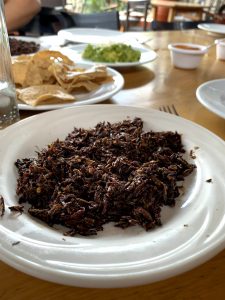
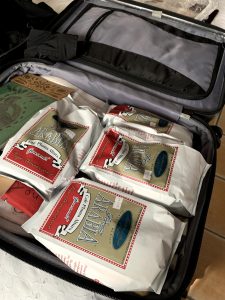
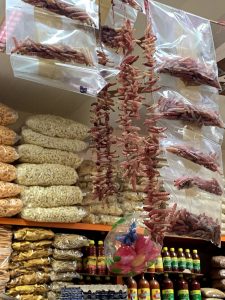
Picture 1: Chapulines, Los Pacos, Oaxaca 2019
Picture 2: Mi maleta antes de volver a Vancouver, Oaxaca 2019
Picture 3: Gusanitos de Maguey, Mercado 20 de Noviembre, Oaxaca 2019
References
Benson, P., & Fischer, E. F. (2007). Broccoli and desire. Antipode, 39(5), 800-820.
